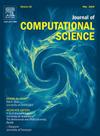Impact of inlet velocity waveform shape on hemodynamics
IF 3.7
3区 计算机科学
Q2 COMPUTER SCIENCE, INTERDISCIPLINARY APPLICATIONS
引用次数: 0
Abstract
Monitoring disease development in arteries, which supply oxygen and nutrients to the body, is crucial and can be assessed using hemodynamic metrics. Hemodynamic metrics can be calculated via computational fluid dynamic simulation of patient-specific geometries. These simulations are known to be heavily influenced by boundary conditions, such as time-dependent inlet flow. However, the effects of inlet flow profiles have not previously been quantified or understood. Here we quantify the effects of modulating temporal arterial waveforms on hemodynamic metrics. Building on our previous work that identified the minimum number of points of interest needed to characterize a left coronary artery inlet waveform, here, we extend this approach to pulmonary and carotid artery waveforms, pinpointing critical points of interest on these waveforms. Using a systematic variation of these points, we quantify the effects on hemodynamic metrics such as wall shear stress, oscillatory shear index, and relative residence time. We simulate using 1D Navier–Stokes and 3D lattice Boltzmann simulation approaches conducted on high performance compute clusters. The results pinpoint parts of the waveform that are most susceptible to perturbations and measurement error. The impacts of this work include the construction of a method that can be applied to other fluid simulations with pulsatile inlet conditions and the ability to distinguish the vital parts of a pulsatile inlet condition for computational fluid dynamic simulations and clinical metrics. This work is an extension of work published at the International Conference on Computational Science (ICCS-2024), (Geddes et al., 2024).
入口速度波形形状对血流动力学的影响
动脉为人体提供氧气和营养,监测动脉疾病的发展至关重要,可以使用血液动力学指标进行评估。血流动力学指标可以通过计算流体动力学模拟患者特定的几何形状来计算。众所周知,这些模拟在很大程度上受到边界条件的影响,例如随时间变化的进口流量。然而,进口气流的影响以前没有被量化或理解。在这里,我们量化调节颞动脉波形对血流动力学指标的影响。我们之前的工作确定了表征左冠状动脉入口波形所需的最小兴趣点数量,在此基础上,我们将这种方法扩展到肺动脉和颈动脉波形,确定这些波形上的关键兴趣点。利用这些点的系统变化,我们量化了对血流动力学指标的影响,如壁面剪切应力、振荡剪切指数和相对停留时间。我们使用在高性能计算集群上进行的一维Navier-Stokes和三维晶格Boltzmann模拟方法进行模拟。结果精确定位了波形中最容易受到扰动和测量误差影响的部分。这项工作的影响包括建立了一种可以应用于具有脉动入口条件的其他流体模拟的方法,以及区分计算流体动力学模拟和临床指标的脉动入口条件的重要部分的能力。这项工作是在国际计算科学会议(ICCS-2024)上发表的工作的延伸(Geddes et al., 2024)。
本文章由计算机程序翻译,如有差异,请以英文原文为准。
求助全文
约1分钟内获得全文
求助全文
来源期刊

Journal of Computational Science
COMPUTER SCIENCE, INTERDISCIPLINARY APPLICATIONS-COMPUTER SCIENCE, THEORY & METHODS
CiteScore
5.50
自引率
3.00%
发文量
227
审稿时长
41 days
期刊介绍:
Computational Science is a rapidly growing multi- and interdisciplinary field that uses advanced computing and data analysis to understand and solve complex problems. It has reached a level of predictive capability that now firmly complements the traditional pillars of experimentation and theory.
The recent advances in experimental techniques such as detectors, on-line sensor networks and high-resolution imaging techniques, have opened up new windows into physical and biological processes at many levels of detail. The resulting data explosion allows for detailed data driven modeling and simulation.
This new discipline in science combines computational thinking, modern computational methods, devices and collateral technologies to address problems far beyond the scope of traditional numerical methods.
Computational science typically unifies three distinct elements:
• Modeling, Algorithms and Simulations (e.g. numerical and non-numerical, discrete and continuous);
• Software developed to solve science (e.g., biological, physical, and social), engineering, medicine, and humanities problems;
• Computer and information science that develops and optimizes the advanced system hardware, software, networking, and data management components (e.g. problem solving environments).
 求助内容:
求助内容: 应助结果提醒方式:
应助结果提醒方式:


